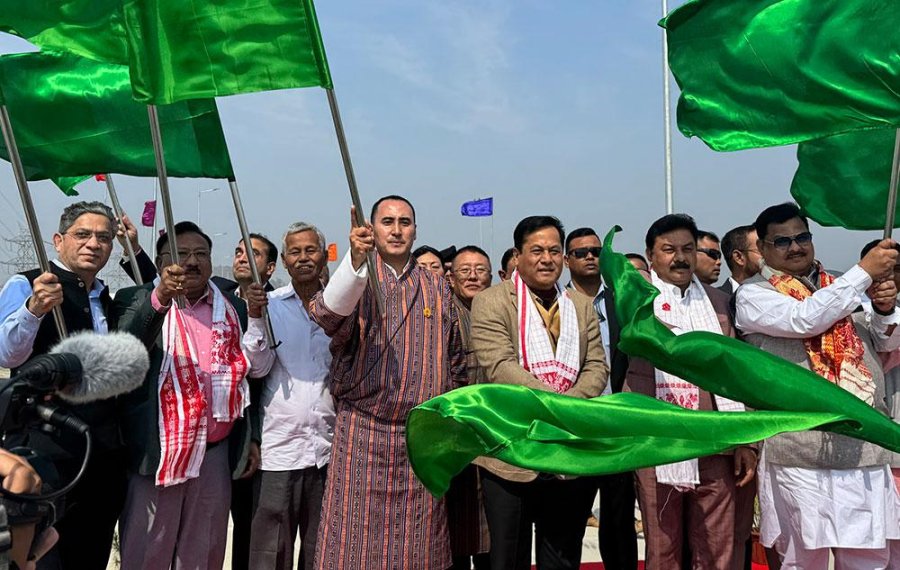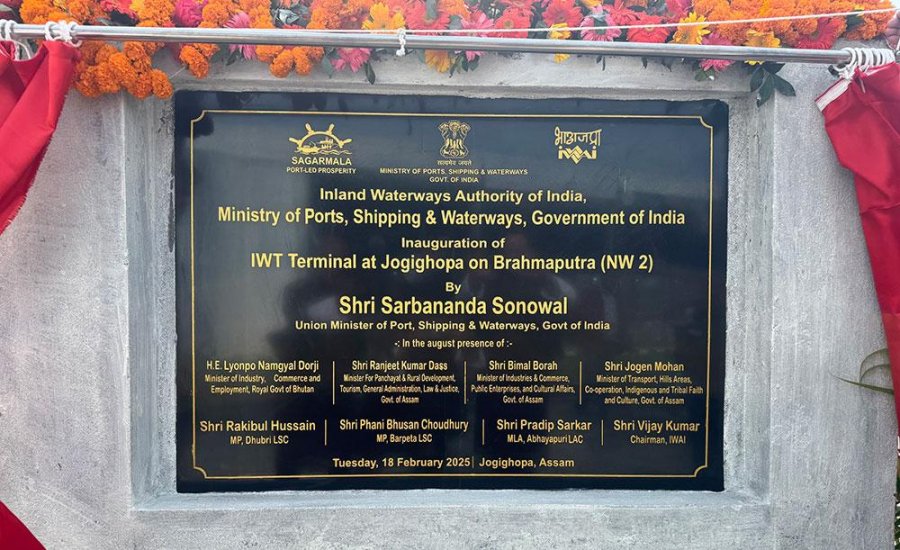February 21, 2025
ASSAM – Bhutan has now access to its closest riverine trade hub with the inauguration of the Jogighopa Inland Water Transport (IWT) terminal on the Brahmaputra River in Assam, India—just 91 kilometres from Gelephu.
The terminal, located in Bongaigaon district, is expected to transform regional trade, providing a more efficient, cost-effective route for Bhutanese exports to Bangladesh and India.
The inaugural shipment, carrying 110 metric tonnes of coal and stone chips to Bangladesh, was flagged off on February 18 by Indian Union Minister of Ports, Shipping and Waterways, Sarbananda Sonowal, and Bhutan’s Minister of Industry, Commerce, and Employment, Namgyal Dorji.
The terminal, part of India’s effort to enhance National Waterway 2 on the Brahmaputra, is a major cargo and river tourism hub. Located 108 km from the Bangladesh border and 147 km from Guwahati via waterways, it is set to boost trilateral trade between Bhutan, Bangladesh, and India.

Lyonpo Namgyal Dorji joined Indian Union Minister Sarbananda Sonowal and other ministers of Assam government to flag
off the inaugural shipment to Bangladesh. PHOTO: KUENSEL
Speaking at the event, Lyonpo Namgyal Dorji said that with the operation of the terminal, Bhutan stands to benefit from greater trade efficiency, reduced logistics costs, and enhanced export potential. “Beyond India, it will greatly boost our existing trade and exports to Bangladesh,” he said.
“Furthermore, this terminal will play a pivotal role in advancing the goals of the upcoming Gelephu Mindfulness City, providing a sustainable and efficient transport link to global markets,” Lyonpo said. “What is coming here indeed holds great potential and promise for our cooperation and collaboration.”
The IWT is a key port for trade between India and Bangladesh, following the memorandum of understanding (MoU) to develop an economic corridor under the Bharatmala Programme, including the Dalu-Tura-Goalpara-Gelephu multi-modal route.
Indian Union Minister Sarbananda Sonowal said the terminal will transform regional connectivity, particularly for Bhutan, India, and Bangladesh. “Its strategic position enables it to serve as an economic multiplier for the region, exemplifying Prime Minister Narendra Modi’s ‘Neighbourhood First’ doctrine,” he said.
Currently, boulders from Gelephu are exported to Bangladesh and India via surface transportation to Dhubri Port (133 km) in Assam and Nakugaon (281 km) in Bangladesh. Reaching Bangladesh requires crossing two Indian states—Assam, and Meghalaya—making transportation both challenging and costly.

Jogighopa IWT was inaugurated on February 18, 2025. PHOTO: KUENSEL
Most shipments rely on Indian trucks, with only a handful of Bhutanese truckers involved, often facing logistical and regulatory hurdles along the highways. However, exporters say the Jogighopa terminal will significantly reduce travel distances and allow for greater involvement of local Bhutanese truckers.
Exporter of Dendup Mines and Minerals in Gelephu, Lobzang Tsering, said the operation of the Jogighopa terminal will make the export and import of raw materials more convenient. “We previously attempted to ship via Jogighopa, but without a proper water terminal, we had to rely on Dhubri. Now, this will be a game-changer for logistics,” he said.
The owner of Vajrataa Exporters, Chencho Gyeltshen, said the facility would not only boost revenue but also expedite trade documentation. “The terminal will help clear letters of credit (LCs) faster, allowing for daily shipments instead of the four-day delays we face at other ports,” he said.
However, traders still face bureaucratic delays at border checkpoints in Bhutan and India, which slow down exports.
“If a dedicated customs counter were set up to fast-track documentation, we could dispatch two shipments a day, as the border gate operates 24 hours,” Chencho Gyeltshen said. “Both countries will benefit as we employ Indian trucks.”
While inland waterways offer a cheaper alternative to road transport—allowing large cargo volumes to move at once, particularly during the monsoon—exporters remain concerned about seasonal fluctuations. During winter, reduced water levels in the Brahmaputra can prevent cargo vessels from operating at full capacity.
Built at a cost of INR 820 million on a 15-acre site, the Jogighopa terminal features a reinforced cement concrete (RCC) jetty, storage facilities, parking areas, customs and immigration offices, and amenities for traders and truckers.
A four-lane road connects it to the national highway, while a planned railway broad gauge siding will further enhance its connectivity with the Multi-Modal Logistics Park at Jogighopa.
The terminal will handle key commodities such as food grains, fertilizers, coal, petroleum products, edible oil, fly ash, and stone chips.
Bhutanese officials said that the terminal’s strategic location will help Bhutan facilitate smoother export and import processes, particularly for key goods such as agricultural products, boulders, and manufactured items to India and Bangladesh.
In December 2020, the Indian government agreed to open the Jogighopa terminal along with Nagarkata, Agartala, and Pandu to boost trade and transit. Bhutan also signed an MoU with Bangladesh to use the Brahmaputra’s inland waterways, accessing Chilmari port.


